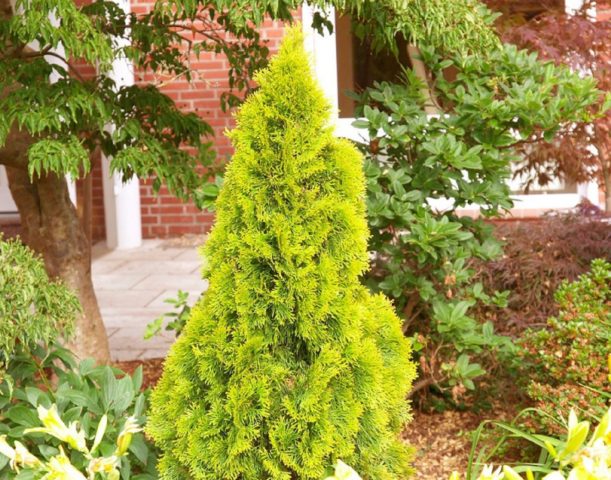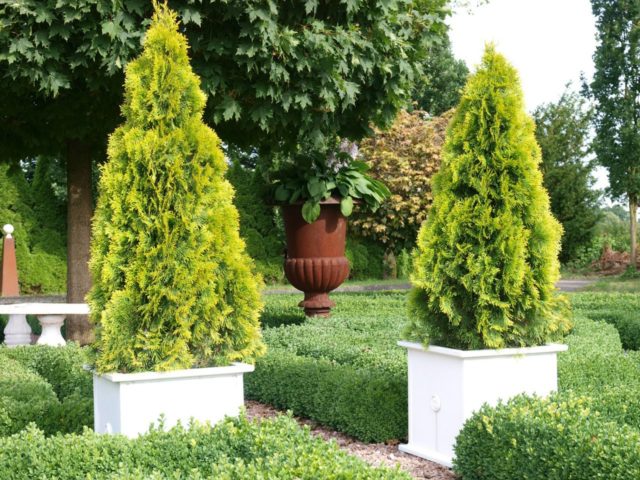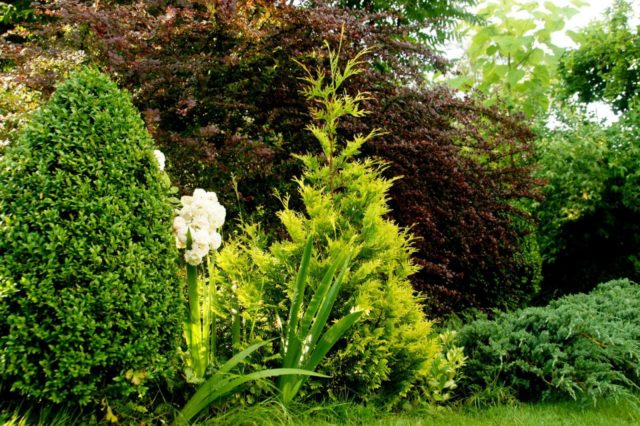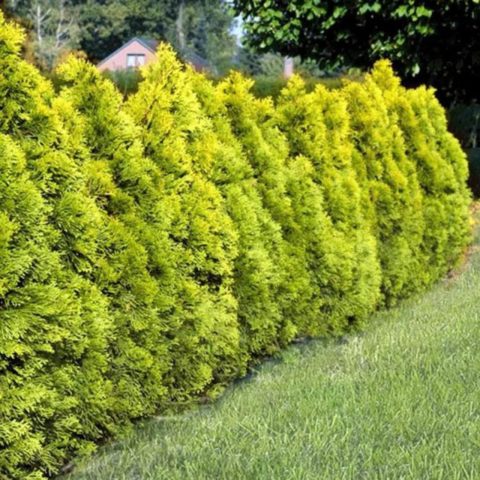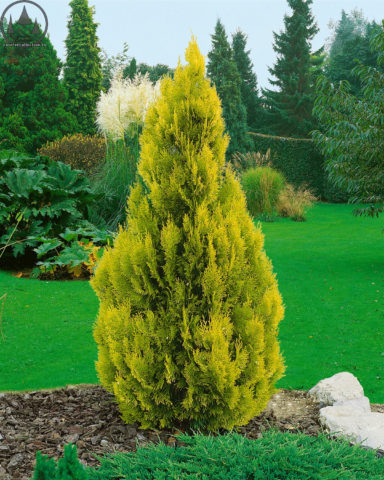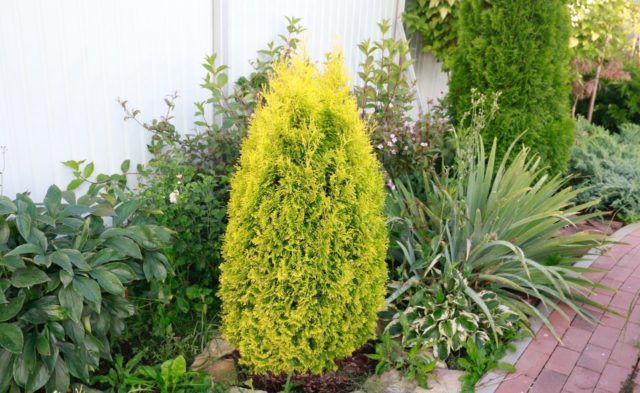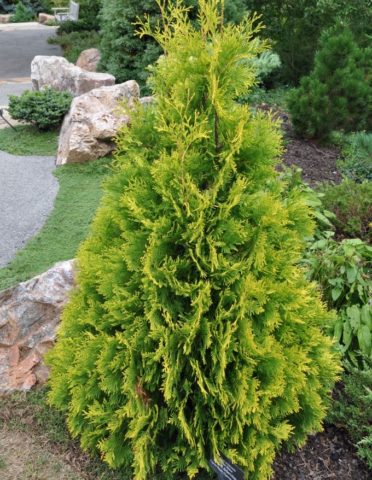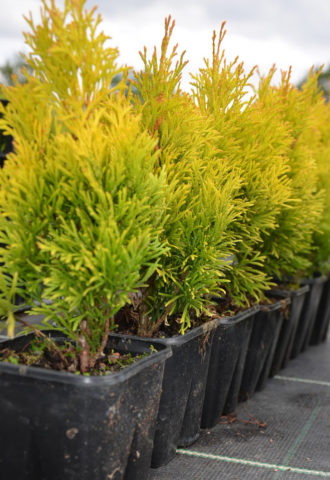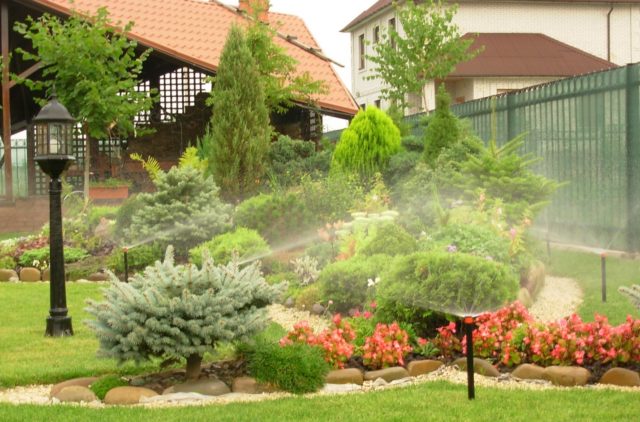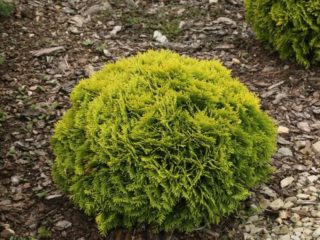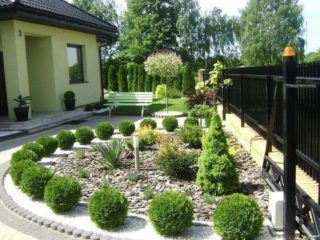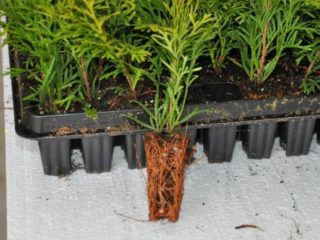Content
The wild western thuja became the ancestor of various varieties used for the decoration of the urban area and private plots. Western thuja Golden Smaragd is a unique representative of the species. The variety was created in Poland, in 2008 thuja took the third prize at an international exhibition.
Description of thuja Golden Smaragd
The western variety of thuja Golden Smaragd is medium-sized. The height of the tree rarely exceeds 2.5 m. Thuja has a minimum annual growth, it is 8-13 cm. The shape is narrow pyramidal, closer to the columnar, the crown volume is 1.3 m. Thuja is a frost-resistant, unpretentious crop with an average degree of drought tolerance.
Description of thuja western Golden Smaragd (pictured):
- The central trunk is of medium diameter, tapering at the top, dark in color with a rough, flaking bark.
- Skeletal branches are short, strong, growing vertically at an angle of 450, converge to one crown.
- Shoots are flexible, thin, light brown with drooping tops. Due to their compact arrangement, they form a dense crown of the correct shape, annual shoots do not go beyond the visual boundaries.
- The needles are soft, scaly, formed tightly to each other along the entire length of the shoots. At the base, it is green-yellow, closer to the upper part, the green tint is completely replaced by a bright golden one. At the end of the shoots, young needles are colored maroon.
- Thuja forms small cones every year, they are oval, dark brown, 1 cm long.
Thuja varieties Golden Smaragd belongs to evergreen perennial plants. The decorativeness of the habit retains throughout the year, the color does not change by autumn.
The use of thuja Golden Smaragd in landscape design
Thuja of the Golden Smaragd variety is considered an elite variety, popular among landscape designers. Thuja is used for decorating the territories of personal plots, as well as decorating flower beds adjacent to the facade of office buildings. For mass landscaping of urban recreation areas, the Golden Smaragd variety is rarely used, since the price of planting material is quite high.
Thuja Golden Smaragd with a bright color and the correct shape of the crown, due to its small growth, does not require constant haircut. Not the last factor in choosing a variety is 100% rooting of seedlings on the site. Thuja is combined with various varieties of conifers, flowering herbaceous shrubs. It favorably emphasizes large size and dwarf forms. Thuja is planted as a tapeworm or in a group. Below in the photo are some examples of how you can use the western thuja Golden Smaragd in the decorative design of the landscape.
On a flowerbed in front of the central entrance to the building.
Thuja on the sides of the garden path
In a group planting with flowering plants and ornamental shrubs.
Golden Smaragd in mass planting as a hedge.
Thuja as a tapeworm in combination with horizontal juniper for lawn decoration.
Thuja serves as a color accent in the design discounts.
Rockery landscaping foreground.
Breeding features
The Golden Smaragd varieties are propagated independently by seeds and vegetatively. Cones ripen in the second decade of September. The resulting planting material is planted immediately on the site or in February in containers for seedlings.After sowing seeds in the fall, the garden bed is mulched with fine wood chips. During the winter months, the seeds of the thuja variety Golden Smaragd will undergo stratification, and young shoots will sprout in the spring. Before planting, the material is placed in containers for 30 days in the refrigerator.
The vegetative method of propagation of the Golden Smaragd cultivar includes grafting and obtaining seedlings from cuttings. For harvesting cuttings, last year's shoots are chosen. To do this, retreat 5 cm, cut off, then cut the cuttings 15 cm in size. Remove the needles from the bottom. Thuja is placed in the ground at an angle, covered with a film on top on arcs. The work is carried out in July.
Breeding activities for the western thuja Golden Smaragd with layering begin in the spring. The material is obtained from the lower branch close to the surface of the earth. Several cuts are made on it, fixed in a shallow furrow, and fall asleep. Next spring, they are carefully removed from the soil, the places with rooted buds are cut and planted in a mini-greenhouse, the thuja will remain in it for another 2 years.
Landing rules
The decorativeness of the future tree depends on the correctly chosen cutting and the place for its further growth. Planting material with thin roots and an undeveloped central part will not be suitable for reproduction, thuja will not be able to take root. Attention is paid to the external state of the needles, the needles should be thick, soft, without dry areas and with a bright color.
Recommended timing
According to the varietal description, thuja western Golden Smaragd is a frost-resistant plant that calmly responds to a decrease in temperature to -33 0C, the winter hardiness of the culture is also high, a sharp spring drop in temperature to -7 0C is not reflected on thuja.
These are the features of an adult tree, thuja under the age of 4 years is less resistant to natural factors, therefore, planting a plant in a temperate climate is carried out only in spring (in May), the signal for placing a thuja on the site is the heating of the soil to + 6 0C. In the South, the planting in the spring is oriented to the soil temperature, in the fall they plant the Golden Smaragd thuja at the end of September, before the frost the seedling will take root safely.
Site selection and soil preparation
The decorativeness of thuja Smaragd Gold completely depends on the illumination of the site. In the shade, the needles are faded, the crown is loose, so a place for thuja is allocated in an open space. The optimum acidity of the soil is neutral, but slightly acidic is also suitable. The soil is light, fertile, with satisfactory drainage, and enriched with oxygen. Preference is given to clayey sandy loam, the occurrence of groundwater should not be too close to the surface.
The area under the thuja is dug up, weeds are removed, if necessary, the composition is neutralized with alkali-containing agents, a mixture of nitrogen, phosphorus and potassium is added (about 120 g per seat). For better rooting, a substrate is prepared from compost, topsoil, sand and peat before planting.
Landing algorithm
The root of a seedling variety Golden Smaragd is dipped in Kornevin for 3 hours. During this time, they dig a hole 65 cm deep. The width depends on the size of the thuja root, the size is determined taking into account that 10 cm of empty space remains to the walls of the recess.
The sequence of planting thuja western Golden Smaragd:
- The bottom of the planting hole is closed with a drain.
- Pour 15 cm of the nutrient mixture on top.
- Tuuya is placed in the center, the roots are distributed so that they are not tangled.
- Pour out the rest of the substrate, tamp.
- The hole is filled to the brim with soil, compacted, the neck should remain at the surface level.
In mass planting, the interval between the pits is 1.2-1.5 m, the thuja reacts poorly to a close arrangement.
Growing and care rules
According to gardeners, thuja western Golden Smaragd does not create any special care problems. Formative pruning is not required for the plant, preparations for winter are not laborious.The main attention is paid to watering and preventing the spread of pests on the thuja.
Watering schedule
In the cultivar Golden Smaragd, only the central part of the root is deepened, the main interwoven system is close to the surface, therefore, constantly waterlogged soil provokes the development of rot. The lack of water affects the condition of the needles, it becomes hard, darkens and crumbles, the thuja loses its decorative effect.
The daily watering rate for an adult tree is in the range of 5-7 liters, for seedlings, drying out of the root ball is destructive, therefore the earth must be constantly moist. The irrigation schedule directly depends on the rainfall. Thuja intensively gives off moisture during the day, it evaporates from the needles. If the summer is hot and the humidity is low, the thuja is watered completely, not only at the root, but also sprayed on the crown. To prevent thuja from getting sunburn, sprinkling is carried out in the evening or in the morning.
Top dressing
Fertilize the cultivar Golden Smaragd after three years of vegetation. In the spring, complex mineral fertilizers are applied, which should contain phosphorus and potassium. In mid-June, thuja is fed with nitrogen-containing agents. At the end of summer, along with watering, they fertilize with organic matter.
Pruning
If the purpose of pruning is to give the crown a certain shape, events are held at the end of summer. Most often, thuja is not formed, since it has a strict geometric shape that does not require correction. A prerequisite for agricultural technology is health-improving pruning. In spring, broken or dry branches are removed for sanitary purposes, shoots with dry or frozen needles are cut off.
Preparing for winter
Thuja of this variety is a frost-resistant culture that can winter without insulation. Preparation for the cold season is as follows:
- In October, the thuja is watered with a large volume of water.
- Seedlings spud.
- Double the mulch layer.
- To prevent the branches from breaking under the weight of the snow, they are fixed to the trunk with twine or rope.
Shelter is necessary to protect the thuja not so much from frost as from the burns of the spring sun.
Pests and diseases
Golden Smaragd has a more stable immunity than the classic look. Subject to all the conditions for planting and leaving, thuja practically does not get sick. The infection is caused by waterlogging of the soil or the location of the tree in the shade. With unfavorable factors, thuyu affects late blight. The first foci are localized at the root, then the infection spreads to the crown. Without timely measures, the thuja will die. Eliminate the disease by treating the tree with fungicides, then transplanted to a dry area.
Of the pests that affect the false shield, the pests are eliminated by "Aktellikom", the insecticide is also used for preventive spring treatment. In the rainy season, the thuja aphid can parasitize on the Golden Smaragd variety, get rid of insects with "Karbofos".
Conclusion
Western thuja Golden Smaragd is a compact cone-shaped tree with a bright, dense crown. The yellow-green color of the needles remains throughout the year. Tuyu is classified as an elite variety, grown for the decoration of gardens, personal plots, the front area of administrative and office buildings. Thuja is unpretentious to the composition of the soil, does not require a shaping haircut.

